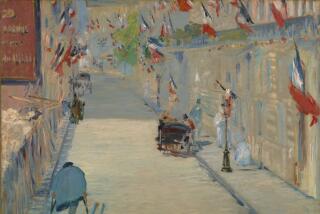Art for Art’s Sake
- Share via
It’s unlikely your Christmas tree, however brightly lit, will outshine the art books piled at its foot this season. The intellectual ambitiousness of some of these volumes, along with their expanded page size and crushing weight on the lap or knees, may seem daunting at first. So I thought when I lifted the new 8-pound, foot-high 10th edition of Helen Gardner’s friendly old 3-pound Art Through the Ages, which so lightly accompanied me to college long ago. But it would be a mistake to consider any of these tomes as an old-fashioned coffee-table picture book to be opened once, then put away.
Sumptuous as they are, these are readers’ books, thick with historical and social facts, psychological anecdote, stylish apercus and illuminating new takes on old subjects. So, as my half-French mother used to say when I’d turn up my nose at one of her miracles of complex cookery, “B’ appetit vien en mangeant.” I’d challenge anyone with eyes and an inquiring mind to let go one of these miracles of postmodern bookmaking.
For example, techniques of color reproduction are so refined today that fidelity is the norm and these are wonderful examples of it. (Will CD-ROMS ever provide such harmonies and perspectives to linger over?) In this eclectic gathering are multicultural marvels--masks of Oceania, multimedia work by African American women and a lovely collection of Native American creation myths--all politically correct but authentic products of serious digging and editing.
Hardcover editions of recent exhibition catalogs--Picasso’s portraits of his friends and lovers in Picasso and Portraiture and the works and world of Corot--are compelling to linger over in book form long after the crowded gallery scene is forgotten. So are stories of American museums and galleries, where credit to the founders can be leavened with gossip about wheeler-dealers of the Italian American art world. Artists who have slipped out of the public eye are always marked for reappraisals: the American William Glackens; the German-born Bernhard Gutman; and “the greatest German painter,” the Goethean universalizer, Adolph Menzel. Nor ought one forget the French Pierre-Paul Prud’hon, master of erotic aesthetic strategies, rivetingly deconstructed here by John Elderfield.
In fact, there is an enjoyable freedom to many of these texts, refreshing after the long freeze when Greenbergian formalism was the rule in art writing. An eloquent and often witty tome is Colin Eisler’s on the treasures of the Berlin museums, Masterworks in Berlin: A City’s Paintings Reunited. His writing has the same “eccentric, loopy authority” he attributes to one German painter. A gorgeously expanded reissue of Bob Haak’s work on the The Golden Age: Dutch Painters of the Seventeenth Century well-earns its reputation. With over a thousand illustrations, it roots the “great flowering” of 17th century painting in political, economic and social circumstances. Another perspective on that troubled, brilliant age, so like ours in many ways, is Andre Chastel’s retranslated and enlarged meditation on French Art: The Ancien Regime 1620-1775. His text is full of such happy asides as that, “in an effort to seduce, the king himself performed in ballets . . . [and] excelled in slow dances, which suited the majesty of his figure.”
One may wonder about the source of the surge of desire for visual expression and contemplation that swept 17th century Europe. If the reason was to shore up memory in a time when many people were coming to think of the world as dark, even doomed to decline, a like impulse may be at work today, providing cause enough to fabricate and own such treasures at these.
(BEGIN TEXT OF INFOBOX / INFOGRAPHIC)
Holiday 1996 / BOOK CITY
ART THROUGH THE AGES by Helen Gardner. (Harcourt Brace: $60, 1200 pp.)
MASTERWORKS IN BERLIN: A City’s Paintings Reunited by Colin Eisler. (Bulfinch/Little, Brown: $125, 704 pp.)
PICASSO AND PORTRAITURE edited by William Rubin. (Museum of Modern Art: $45, 136 pp.)
BERNHARD GUTMAN: An American Impressionist by Percy North. (Abbeville: $65, 199 pp.)
WILLIAM GLACKENS by William H. Gerdts, essay by Jorge H. Santis. (Abbeville: $65, 224 pp.)
THE GOLDEN AGE DUTCH PAINTERS OF THE SEVENTEENTH CENTURY by Bob Haak. (Stewart Tabori & Chang: $75, 336 pp.)
FRENCH ART: The Ancien Regime 1620-1775 by Andre Chastel. (Flammarion: $75, 336 pp.)
COROT edited by Gary Tinterow, Michael Pantazzi, and Vincent Pomarede. (The Metropolitan Museum of Art/Abrams: $65, 322 pp.)
THE LANGUAGE OF THE BODY: Drawings of Pierre-Paul Prud’hon text by John Elderfield drawings selected by Robert Gordon. (Abrams: $65, 221 pp.)
*
And Bear in Mind:
IMPRESSIONISTS SIDE BY SIDE by Barbara Ehrlich White. (Knopf: $60, 293 pp.)
BENOZZO GOZZOLI by Diane Ahl. (Yale University Press: $60, 340 pp.)
More to Read
Sign up for our Book Club newsletter
Get the latest news, events and more from the Los Angeles Times Book Club, and help us get L.A. reading and talking.
You may occasionally receive promotional content from the Los Angeles Times.








